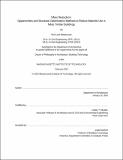| dc.contributor.advisor | Caitlin T. Mueller. | en_US |
| dc.contributor.author | Mayencourt, Paul Louis. | en_US |
| dc.contributor.other | Massachusetts Institute of Technology. Department of Architecture. | en_US |
| dc.date.accessioned | 2021-02-19T20:41:28Z | |
| dc.date.available | 2021-02-19T20:41:28Z | |
| dc.date.copyright | 2020 | en_US |
| dc.date.issued | 2019 | en_US |
| dc.identifier.uri | https://hdl.handle.net/1721.1/129890 | |
| dc.description | Thesis: Ph. D. in Architecture: Building Technology, Massachusetts Institute of Technology, Department of Architecture, February, 2019 | en_US |
| dc.description | Cataloged from student-submitted thesis. | en_US |
| dc.description | Includes bibliographical references (pages 143-153). | en_US |
| dc.description.abstract | .Mass timber, a contemporary type of wood construction using engineered wood products, sourced from sustainably managed forests, has the potential to reduce the carbon emissions of the construction sector and act as a climate mitigation solution. Mass timber buildings made from renewable wood material can store carbon over their life cycles and support the regeneration of forests. Unfortunately, in the current market conditions in North America, a modern mass timber construction can cost up to 5-15% more than a conventional building, resulting in a low likelihood of wide adoption beyond green construction trends or environmentally conscious clients. There is, however, a missed opportunity in the way these buildings' structural systems are designed: up to 66% of structural material is under-utilized as a result of standardization because it is more convenient to manufacture. Structural optimization and new manufacturing techniques (i.e. digital fabrication) offer ways to design and manufacture customized structural elements with higher material efficiencies. This dissertation presents three new structural design methodologies to reduce cost through a reduction of material use in modern mass timber buildings. Each methodology addresses a standard structural element with high-recurrence and low material efficiency. The first methodology examines the design of hollow cross-laminated timber panels. The second methodology was developed to design shaped structural timber beams. The last methodology expands the design of shaped beam elements to frame structures. The results demonstrate that a total cost reduction of 5-7% can be achieved from structural material savings of 16-26%. A reduction of the total cost of mass timber structures is then likely to increase their competitiveness against other structural solutions and drive a greater implementation of sustainable mass timber as a climate mitigation solution. | en_US |
| dc.description.statementofresponsibility | by Paul Louis Mayencourt. | en_US |
| dc.format.extent | 156 pages | en_US |
| dc.language.iso | eng | en_US |
| dc.publisher | Massachusetts Institute of Technology | en_US |
| dc.rights | MIT theses may be protected by copyright. Please reuse MIT thesis content according to the MIT Libraries Permissions Policy, which is available through the URL provided. | en_US |
| dc.rights.uri | http://dspace.mit.edu/handle/1721.1/7582 | en_US |
| dc.subject | Architecture. | en_US |
| dc.title | Mass reduction : opportunities and structural optimization methods to reduce material use in mass timber buildings | en_US |
| dc.title.alternative | Opportunities and structural optimization methods to reduce material use in mass timber buildings | en_US |
| dc.type | Thesis | en_US |
| dc.description.degree | Ph. D. in Architecture: Building Technology | en_US |
| dc.contributor.department | Massachusetts Institute of Technology. Department of Architecture | en_US |
| dc.identifier.oclc | 1237121372 | en_US |
| dc.description.collection | Ph.D.inArchitecture:BuildingTechnology Massachusetts Institute of Technology, Department of Architecture | en_US |
| dspace.imported | 2021-02-19T20:40:58Z | en_US |
| mit.thesis.degree | Doctoral | en_US |
| mit.thesis.department | Arch | en_US |
